Do you constantly generate marketing reports that aren’t helpful in strategy creation?
Knowing the intricacies of marketing reports can help you decipher where traffic and potential leads come from. You get to see how these leads interact with your website and what converts them into customers.
But marketers often become frustrated with manual data collection and reports that don’t offer strategic insights. This doesn’t have to be your situation.
This detailed guide from marketing experts will help you master marketing reports. You’ll learn how to generate excellent reports that offer proper insights, to make informed decisions for your next marketing campaign.
Let’s get started.
What is a marketing report?
A marketing report is a comprehensive document that evaluates and analyzes data from different marketing channels. It measures the data against key performance indicators and goals, and provides a holistic view of your campaign’s performance.
A marketing analysis report includes information on:
- Expected outcomes
- Overall goals
- Email and ad campaigns
- Promotions
- Marketing research and user analysis
- Marketing strategy
- Campaign results
- Recommendations
- Impressions
- Budget and spending
Marketing reports are created for different channels, including social media, paid advertising, and content marketing. Each of these campaign reports shows you marketing KPIs specific to that channel.
They help you understand what’s working and what isn’t. You also learn how to improve future marketing strategies with the right data.
Why are marketing reports important?
Marketing reports provide marketing strategy and budget recommendations. They also help you keep track of campaigns. Here are some other reasons these reports are crucial:
- Insightful decision-making: Marketing reports can provide a data-driven foundation for making informed business decisions.
- Performance evaluation: A marketing performance report can help you assess the performance of your marketing strategies and campaigns.
- Resource optimization: You can assign the budget more efficiently with these reports.
- Track customer journey: These reports tell you where prospective customers are on their journey. You can track their IP address and see their operating systems when they make a purchase.
- Access data easily: Automated marketing reports give you easy access to the data for marketing channels.
What makes a good marketing report?
A good marketing report shows you more than just numbers. It gives you meaningful, actionable insights to help your business grow.
Let’s discuss all the points that make up a good marketing report.
- Clarity and conciseness: A good marketing report presents information clearly. It doesn’t have unnecessary jargon or complexity.
- Relevant metrics: A marketing report should focus on key performance indicators (KPIs) that align with your business goals, like ROI and click-through rates. This gives you a clear view of how effective your marketing campaigns are for the things that matter most.
- Visual representation: Charts, graphs, and visuals are part of a good marketing report. These elements transform raw information into engaging data that you can understand easily.
- Meaningful analysis: It should provide valuable data analysis that shows patterns, trends, and potential areas of improvement in your marketing strategy.
- Comparative data: An excellent marketing report provides context by using comparisons and benchmarks. This allows you to gauge performance against past marketing campaigns and industry standards.
Here’s an example of what a good marketing report looks like:
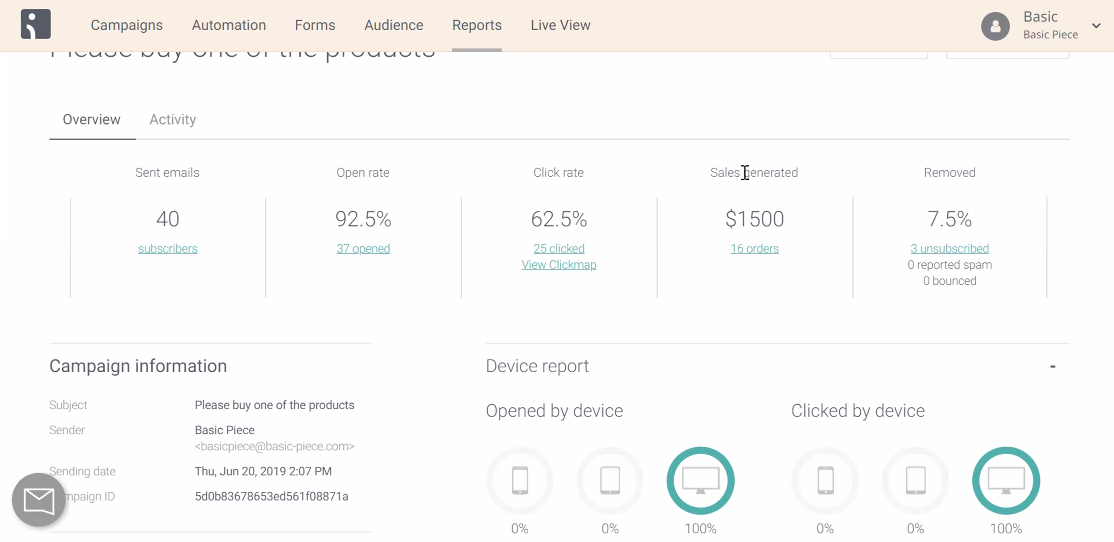
Main marketing reports examples
Marketing reports aren’t one-size-fits-all. You need to create specific reports for specific channels.
Let’s explore common marketing report examples.
General marketing report
A marketing report example shows you a broad overview of all your marketing channels. You get insights into the performance of marketing channels like:
- Paid advertising
- Ecommerce analytics
- Social media marketing
- Search engine optimization
- Content marketing
A general marketing report also shows you details on performance metrics, like:
- Number of users
- Sessions
- Average time on page
- Goal completions
- Bounce rate
Here’s a sample of a general marketing report template:
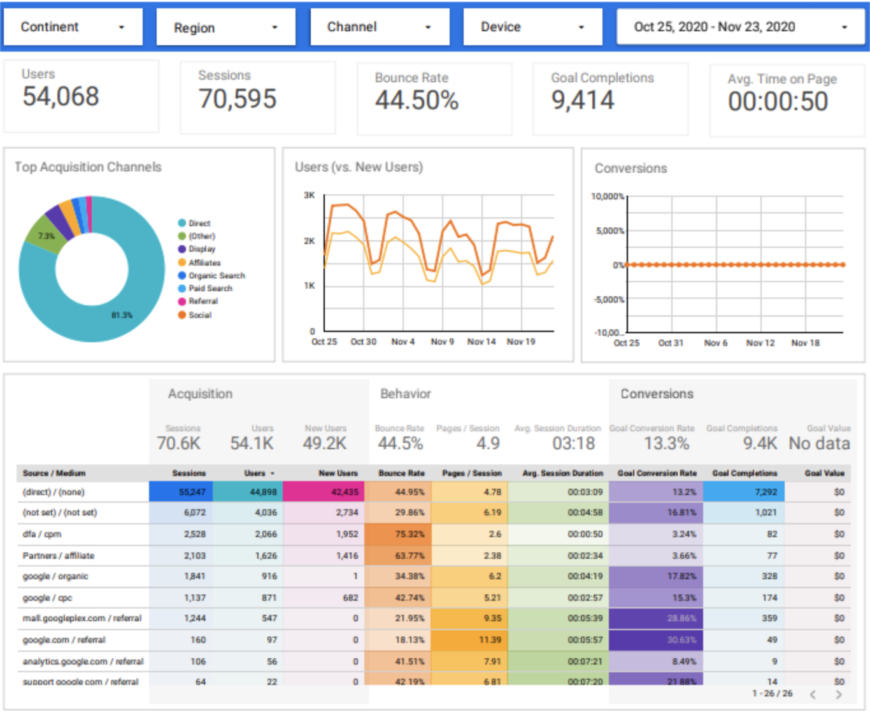
Email marketing report
Generate a separate email marketing report to monitor your email campaign performance. This tells you how many people opened your email and how many converted to sales.
Even better, you can track metrics like:
- Conversion rates
- Click-through rates
- Number of emails sent
These advanced reports show you how different customer groups respond to email campaigns, and help you assess the effectiveness of your email marketing campaign.
You can connect your email campaigns to the report to get regular updates on details like:
- Unique opens
- Successful deliveries
- Total subscribers
- Click rate
- Unique clicks
- Total unsubscribers
SEO marketing report
SEO reports can give you insights into how well your strategy is going. As such, they can help with your search engine optimization and long-term digital marketing plans.
This report focuses on the organic performance of your website and content. It also gives you insight on:
- Landing pages
- Keyword rankings
- Organic traffic and its sources
- Quality and quantity of backlinks
- Organic conversion
Some SEO reports even have different sections, like:
- Ahrefs metrics on linked root domains, Ref. Pages and backlinks
- Organic goal completions
- Organic sessions
- Google WEB search impressions
- Organic traffic comparison
- Organic search funnel
You can add more metrics and channels, like pages per session and indexed pages, as needed. This gives you a comprehensive, cross-channel report.
Here’s a sample of an SEO marketing report:
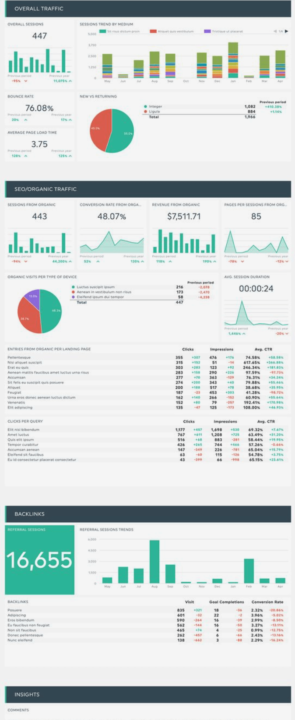
PPC marketing report
A pay-per-click marketing report provides detailed information on all your paid ads and promotions. It gathers this information from different platforms like YouTube, Google ads, Facebook, X (formerly Twitter), Instagram, and LinkedIn.
You also get insights on the conversions, number of channels, and all your budget spending. In addition, you can add metrics like:
- Conversion rates on all channels
- Ad performance of every platform
- Cost-per-click
- Click-through rate
To get a consolidated view, PPC marketing reports may also have sections on:
- Main KPIs like costs per click, impressions, clicks, time frame, and conversions
- Competitor analysis
- Recommendations on further actions to improve your marketing strategy
- Analysis of budget distribution across campaigns, ad groups, and keywords
- Analysis of ad copy to check the impact of ad messaging
This example shows you what a PPC marketing report may look like:
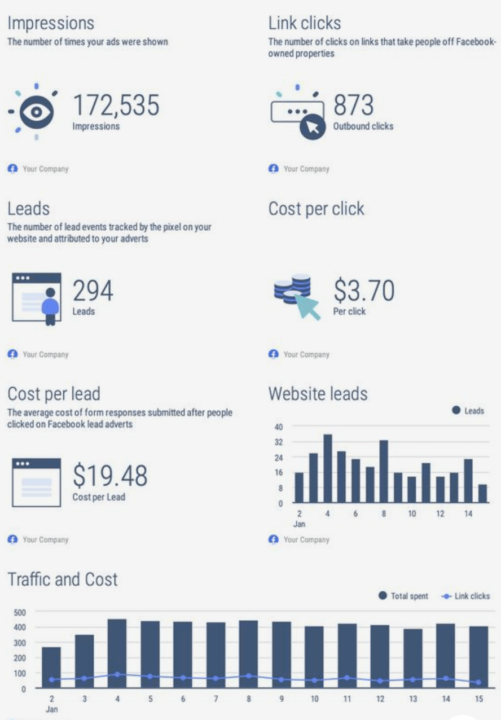
Social media marketing report
This marketing report format assesses the effectiveness of your organic and inorganic social media marketing efforts. These include paid channels like Facebook Ads, Instagram Ads, and sponsored posts on social media like videos and pictures.
It also gets information from popular social media platforms like LinkedIn, YouTube, Instagram, and X.
You get insights on important metrics, such as:
- Top performing posts
- Follows and likes
- Engagement, such as the number of comments and shares
- Audience demographics
- Overall reach
Grouping your data by channel gives an overview of how individual platforms are performing. It also helps you compare them with each other.
Here’s an example of a social media marketing report:
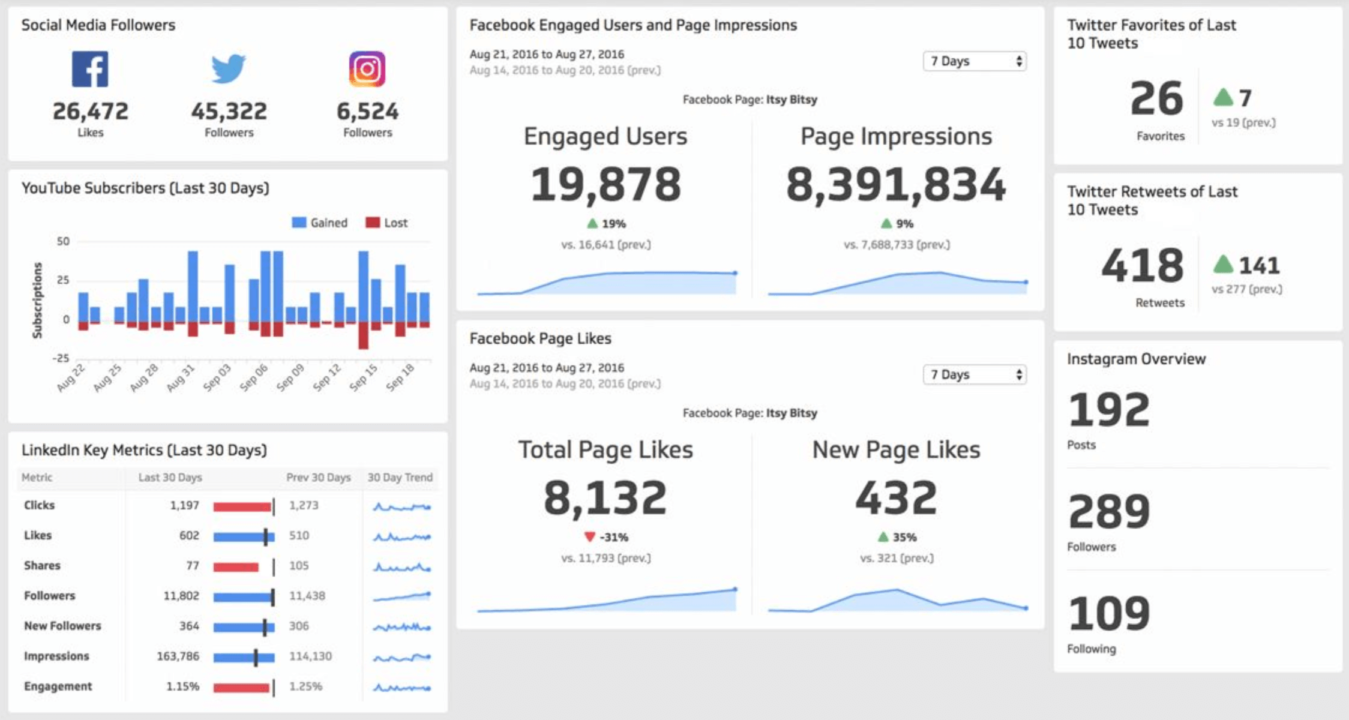
Ecommerce marketing report
This marketing report is tailored for businesses with online stores. Its focus is on metrics important for tracking online sales.
This includes:
- Average order value
- Bounce rates
- Number of transactions
- Conversion rates
- Pages per session
- Overall revenue
- Top-selling and underperforming products
- Reasons behind cart abandonment
- Cart abandonment rates
- Customer demographics
The good thing is that you don’t have to pull these metrics manually. You can connect your account to the report and get updates automatically.
With ecommerce marketing reports, you can refine your ecommerce strategies. You can also optimize product offerings and create a seamless customer experience. This helps you drive sales and build lasting customer relationships.
How do you write a marketing report?
Some marketing reports are almost entirely data. Others are filled with text, and they explain recommendations and analyses.
If your report relies heavily on data, it’s important to clearly explain each graph, table, or chart. You can use small headers at the top of the visuals, like this:
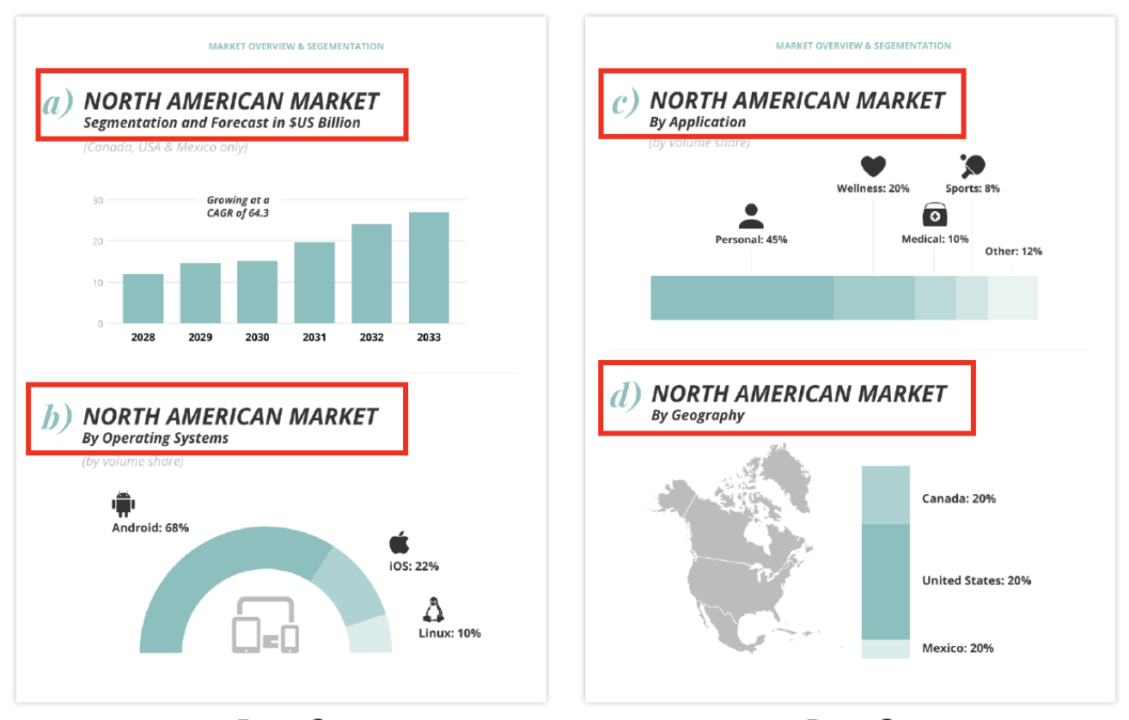
Depending on the purpose of the report, you can add more details, key findings, and analysis like this:
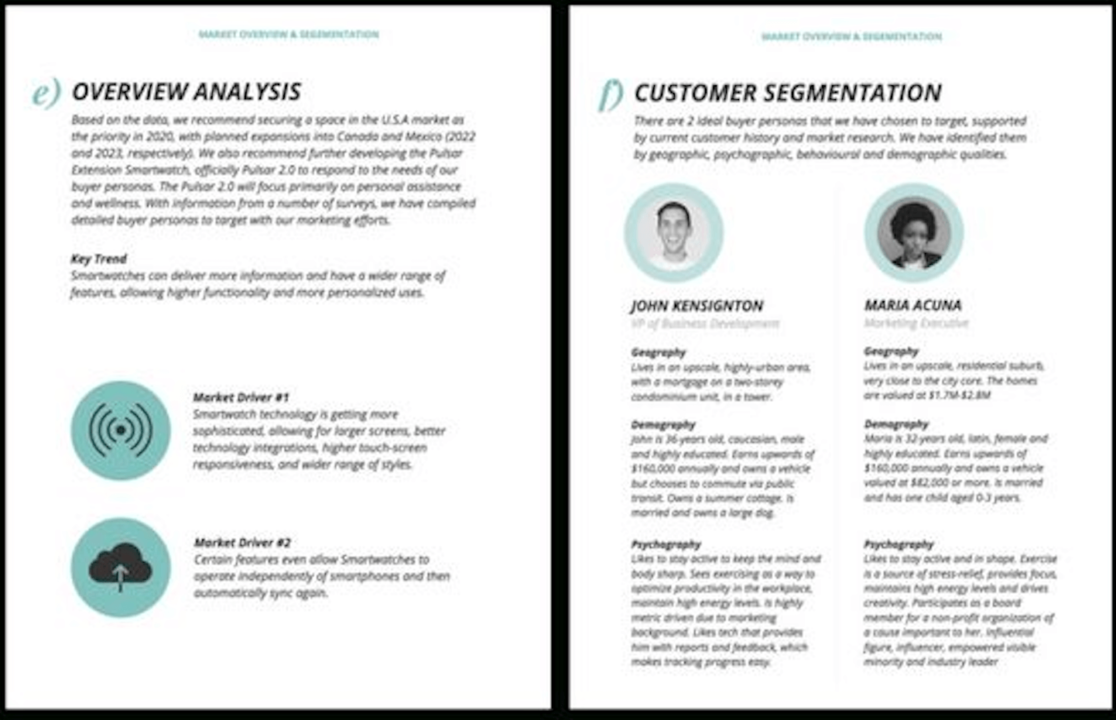
Decide the type of report you want to create and choose a marketing report template that fits. Then, edit the content with the necessary details.
You can also customize the report by using your logos and brand colors.
Some other tips to consider when writing your marketing report include:
- Start the report with an executive summary, highlighting key findings and recommendations.
- Clearly outline the goals and objectives of the report.
- Choose metrics that align with the report’s objectives. Focus on KPIs that offer meaningful insights into your marketing strategies.
- Use visuals, graphs, and charts for better clarity.
- Ensure visuals match the chosen metrics. This contributes to the overall clarity of the report.
- Suggest areas and strategies for improvement based on findings.
- Provide context to numbers, explaining their implications for your business’s marketing objectives.
How often should you make marketing reports?
Various factors determine the frequency of marketing reports. It depends on data availability, business goals, and the run time of campaigns.
Weekly reports are helpful for ongoing promotions and businesses in a fast-paced industry. They can offer accurate insights into short-term campaign performance.
However, bi-weekly marketing reports strike a balance between timely updates and deeper analysis. This regularity helps identify changing trends and maximize opportunities to improve your strategy.
A monthly marketing campaign report can also provide an overview of long-term trends and performance metrics. This facilitates strategic goal alignment and decision-making.
Align your reporting frequency with your business objectives. This helps you monitor progress, identify trends, and make data-driven decisions. It also fosters accountability and facilitates collaboration with clients, executives, and stakeholders.
Wrap up
That’s it! With this guide, you can master marketing reports.
We’ve compiled some excellent marketing report samples to inspire your next report. However, creating these reports for specific purposes is essential.
Ensure that your reports are easy to understand. Also, consider your business goals and campaign intensity when deciding the frequency of these reports.
Ominsend enables you to create and run campaigns and generate comprehensive reports, and provides advanced features for improving your marketing strategy.
Source from Omnisend
Disclaimer: The information set forth above is provided by omnisend.com independently of Alibaba.com. Alibaba.com makes no representation and warranties as to the quality and reliability of the seller and products.








